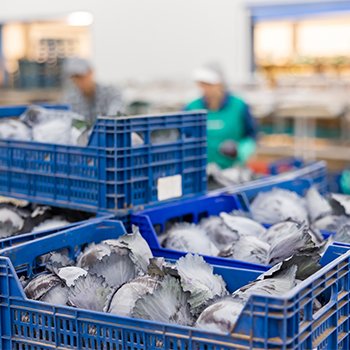Cold Chain Logistics: การจัดการผลผลิตทางการเกษตรและอาหารเพื่อเป้าหมาย SDGs ด้วย โลจิสติกส์โซ่ความเย็น Cold Chain Logistics: Managing Agricultural and Food Products with Cold Chain Logistics to Achieve SDGs
1589 Views |

Cold Chain Logistics: การจัดการผลผลิตทางการเกษตรและอาหารเพื่อเป้าหมาย SDGs ด้วยโลจิสติกส์โซ่ความเย็น
Cold Chain Logistics: Managing Agricultural and Food Products with Cold Chain Logistics to Achieve SDGs
By: ดร. สรพล บูรณกูล
Sorapol Buranakul, Ph.D.
College of Logistics and Supply Chain
Sripatum University
sorapol.bu@spu.ac.th
แนวทางการปรับปรุงเพื่อลดความสูญเสียผลผลิตสินค้าเกษตรและอาหารในโช่อุปทาน
แนวทางที่ 1 การจัดการอุณหภูมิตลอดโซ่อุปทาน แนวทางนี้เป็นวิธีการหลักในการลดความสูญเสียผลผลิตระหว่างกระบวนการ ซึ่งจะส่งผลต่อการลดอาหารที่ถูกทิ้งหรือขยะอาหารที่ท้ายกระบวนการ โดยวิธีการควบคุมอุณหภูมิและความชื้น (Temperature and Humidity Control) ตลอดโซ่อุปทาน เรียกว่าการจัดการโซ่ความเย็น (Cold Chain Management) โดยเฉพาะในกิจกรรมโลจิสติกส์ที่ประกอบด้วย การเก็บรักษา การบรรจุภัณฑ์ การขนส่ง และการกระจายสินค้า ซึ่งการทําความเย็นและการควบคุมความชื้นที่เหมาะสมกับชนิดของผลิตภัณฑ์เกษตรและอาหารจะสามารถยืดอายุผลผลิตให้สามารถคงคุณภาพได้ อาทิ ช่วยทำให้ผลไม้สุกและเน่าเสียช้าลง สามารถคงรสชาติเดิมได้นาน โดยอุณหภูมิที่เหมาะสมจะแตกต่างกันตามชนิดของผลิตภัณฑ์เกษตรและอาหาร รวมถึงวัตถุประสงค์ในการใช้ประโยชน์ ดังนี้
- ผักและผลไม้: อุณหภูมิที่เหมาะสมในการจัดเก็บ คือ 0°C ถึง 15°C
- อาหารแช่เย็น (Chilled): อุณหภูมิที่เหมาะสมในการจัดเก็บ คือ 0°C ถึง 8°C โดยในส่วนของอาหารพร้อมรับประทาน (Ready-to-Eat): อุณหภูมิที่เหมาะสมในการจัดเก็บต้องไม่เกิน 5°C
- อาหารแช่แข็ง (Frozen): อุณหภูมิที่เหมาะสมในการจัดเก็บ คือ -18°C หรือต่ำกว่า
อย่างไรก็ตามในส่วนของการจัดเก็บผักและผลไม้แต่ละประเภทจะมีช่วงอุณหภูมิและค่าความชื้นที่แตกต่างกันออกไป
ดังนั้น กิจกรรมที่มีการควบคุมอุณหภูมิ จะต้องเริ่มตั้งแต่ 1) เกษตรกรหรือในส่วนต้นน้ำ ควรมีการลดอุณหภูมิขั้นต้น (Pre-cooling) ของผลผลิตหลังจากการเก็บเกี่ยว ประกอบด้วยขั้นตอนการตัดแต่ง การคัดแยก และการบรรจุ เช่น การใช้ห้องเย็น (Room Cooling) เพื่อลดอุณหภูมิของผักและผลไม้โดยตรง ซึ่งอาจไม่ต้องใช้วิธีการอื่นที่ซับซ้อน โดยมีการเพิ่มการไหลเวียนของอากาศ หรือการปรับช่องลมของเครื่องทำความเย็นผ่านผลผลิต ผัก และผลไม้ที่อยู่ในภาชนะหรือบรรจุภัณฑ์ที่มีช่องระบายอากาศ หรืออาจใช้น้ำเย็นเป็นตัวกลางในการลดอุณหภูมิ (Hydrocooling) เป็นต้น 2) ในส่วนการขนส่ง มักมีการควบคุมอุณหภูมิด้วยรถห้องเย็น (Refrigerated Container) 3) ในส่วนการเก็บรักษาเพื่อรอการกระจายสินค้าจะใช้การควบคุมอุณหภูมิด้วยระบบห้องเย็น (Cold Storage and Blast Freezer) เรียกว่าคลังสินค้าแช่เย็นหรือแช่แข็ง ซึ่งเป็นอาคารควบคุมอุณหภูมิเพื่อใช้เก็บรักษาและยืดอายุผลิตผลทางการเกษตร อาหารทะเล และผลิตภัณฑ์อาหารที่เน่าเสียง่าย (Perishable Food) อย่างไรก็ตาม การเลือกใช้บรรจุภัณฑ์ที่เหมาะสมสำหรับผัก ผลไม้ และอาหารถือเป็นสิ่งที่สำคัญ เพื่อป้องกันการบีบอัดและช่วยลดการสูญเสียของผลผลิตในระหว่างการขนส่ง
แนวทางที่ 2. การจัดการความต้องการ (Demand Management) คือ การวางแผนจับคู่ความต้องการซื้อ (Demand) กับความต้องการขาย (Supply) เพื่อไม่ให้เกิดผลผลิตโดยที่ไม่มีตลาดรองรับ (Over Production) โดยปัจจุบันได้มีการนำเทคโนโลยีเข้ามาจัดการปัญหานี้ เช่น มีการนำแพลตฟอร์มที่เชื่อมโยงความต้องการของตลาดสินค้าด้านการเกษตรที่รวบรวมผู้ซื้อ (เช่น โรงงานขนาดใหญ่ ร้านค้าปลีกขนาดใหญ่ ผู้ส่งออก โรงแรม และร้านอาหาร) ผู้ผลิต (เกษตรกรและวิสาหกิจชุมชน) รวมถึงผู้ให้บริการด้านปัจจัยการผลิต (เช่น โรงงานบรรจุภัณฑ์ ผู้ให้บริการขนส่ง และสถาบันการเงิน) เข้ามาอยู่ในระบบเดียวกัน โดยระบบจะช่วยจับคู่ผู้ซื้อให้กับเกษตรกร จึงช่วยให้เกษตรกรสามารถวางแผนการเพาะปลูกล่วงหน้าได้ตรงตามความต้องการของผู้ซื้อ รวมถึงมีการบันทึกข้อมูลและควบคุมคุณภาพ พร้อมสร้างความเชื่อมั่นด้วยระบบตรวจสอบย้อนกลับ (Traceability) ในทุกขั้นตอนการผลิต
Improvement guidelines to reduce agricultural product and food losses in the supply chain
1. Temperature management throughout the supply chain: This approach is the primary method for reducing agricultural product losses, which will reduce food waste at the end of the process by controlling temperature and humidity throughout the supply chain. It's called cold chain management, especially in logistics activities, including storage, packaging, transportation, and distribution. Appropriate cooling and humidity control for each type of agricultural product and food can help extend their shelf-life and maintain quality, such as slowing down the ripening and rot of fruits and maintaining the same taste for a longer time. The appropriate temperature for each type of agricultural product and food is different, as follows:
- Fruits and fresh vegetables should be stored at 0°C to 15°C.
- Chilled food should be stored at 0°C to 8°C, while the temperature for ready-to-eat products should not exceed 5°C.
- Frozen food should be stored at a temperature of -18°C or lower.
However, as for vegetables and fruits, the appropriate temperature and humidity ranges vary in detail.
Therefore, activities that require temperature control start with 1) Farmers in the upstream should reduce the initial temperature (pre-cooling) of post-harvest products, including the steps of trimming, sorting, and packing, such as having a room cooling to directly reduce the temperature of vegetables and fruits. This process may not require the use of complex methods. This can be done by increasing air circulation or by adjusting the air vents of the cooler through the products in containers or packaging with ventilation holes. Using cold water can be a mediator for reducing the temperature (hydrocooling). 2) In transportation activities, temperature control should be used with refrigerated containers. 3) For storage activities awaiting product distribution - temperature control is used with a cold storage system (Cold Storage and Blast Freezer) called a refrigerated/frozen warehouse. It is a temperature-controlled building used to preserve and extend the life of agricultural products, seafood, and perishable food products. However, choosing the proper packaging for vegetables, fruits, and food is essential. Packaging prevents compression and helps reduce losses during transportation.
2. Demand Management - planning to match demand with supply so that production does not occur without a market demand. Currently, technology is being introduced to deal with this problem. For example, there is a platform that connects the needs of the agricultural product market. A place that gathers buyers (such as a large factory, a large retail department store (hypermarket), exporters, hotels, and restaurants), manufacturers (farmers and community enterprises), and providers of production factors (such as packaging factories, logistics service providers, and financial institutions) into the same system. The system will help match buyers with farmers. As a result, farmers can make a plan in advance to ensure the cops meet their buyers' needs. Data is recorded and quality controlled. Confidence can be built with a traceability system at every stage of cultivation.






